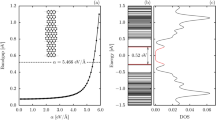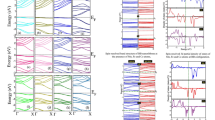Abstract
We study systematically the electron transport through a phenylene rotor with an axis of atomic carbon chain (CPC) connected to twofold symmetric electrodes of nonmagnetic zigzag graphene nanoribbons. The density functional theory combined with the nonequilibrium Green’s function method is employed for the simulation. The CPC rotor is conductive with parabolic I–V characteristic when its ring is coplanar with the electrodes. Its rotation modulates the symmetry of its electron states and their matching to the states in the electrodes. The I–V curve then becomes characterized by sharp peaks with strong negative differential resistance (NDR) in a large range of the rotation angle. The corresponding shift of transport modes in energy with the rotation opens a way to efficient and accurate manipulation of NDR.




Similar content being viewed by others
References
Brandbyge M, Mozos JL, Ordejon P, Taylor J, Scokbro K (2002) Density-functional method for nonequilibrium electron transport. Phys Rev B 65:165401
Capozzi B, Xia J, Adak O, Dell EJ, Liu ZF, Taylor JC, Neaton JB, Luis M. Campos LM, Venkataraman L (2015) Single-molecule diodes with high rectification ratios through environmental control. Nat Nanotechnol 10:522–528
Chen W, Andreev AV (2009) Conductance of a single-atom carbon chain with graphene leads. Phys Rev B 80:085410
Chuvilin A, Meyer JC, Algara-Siller G, Kaiser U (2009) From graphene constrictions to single carbon chains. New J Phys 11:083019
Cui LL, Yang BC, Li XM, Cao C, Long MQ (2014) Effects of symmetry and spin configuration on spin-dependent transport properties of iron-phthalocyanine-based devices. J Appl Phys 116:33701
Dong YJ, Wang XF, Zhai MX, Wu JC, Zhou LP, Han Q et al (2013) Effects of geometry and symmetry on electron transport through graphene–carbon-chain junctions. J Phys Chem C 117:18845–18850
Fang XW, Zhang GP, Yao YX, Wang CZ, Ding ZJ, Ho KM (2011) Electronic transport in large systems through a QUAMBO-NEGF approach: application to atomic carbon chains. Phys Lett A 375:3710–3715
Ghosh AW, Rakshit T, Datta S (2004) Gating of a molecular transistor: electrostatic and conformational. Nano Lett 4:565–568
Guo J (2012) Modeling of graphene nanoribbon devices. Nanoscale 4:5538–5548
Guo YD, Yan XH, Xiao Y (2013a) Electrical control of the spin polarization of a current in “pure-carbon” systems based on partially hydrogenated graphene nanoribbon. J Appl Phys 113:244302
Guo YD, Yan XH, Xiao Y (2013b) Conformational change-induced switching behavior in pure-carbon systems. RSC Adv 3:16672–16680
Husain MM, Kumar M (2015) Negative differential resistance, rectifying performance and switching behaviour in carbon-chain based molecular devices. Org Electron 27:92–100
Jiang B, Zhou YH, Chen CY, Chen KQ (2015) Designing multi-functional devices based on two benzene rings molecule modulated with Co and N atoms. Org Electron 23:133–137
Jin C, Lan H, Peng L, Suenaga K, Iijima S (2009) Deriving carbon atomic chains from graphene. Phys Rev Lett 102:205501
Koleini M, Paulsson M, Brandbyge M (2007) Efficient organometallic spin filter between single-wall carbon nanotube or graphene electrodes. Phys Rev Lett 98:197202
Li XB, Cao LM, Li HL, Wan HQ, Zhou GH (2016) Spin-resolved transport properties of a pyridine-linked single molecule embedded between zigzag-edged graphene nanoribbon electrodes. J Phys Chem C 120:3010–3018
Liew KM, Qiu M, Yuan C (2014) First-principles study of rectifying and switching behavior for different contact positions between sulfur-terminated armchair graphene nanoribbons junctions. EPL 105:58005
Liu YS, Zhang X, Feng JF, Wang XF (2014) Spin-resolved fano resonances induced large spin seebeck effects in graphene–carbon-chain junctions. Appl Phys Lett 104:242412
Martin TB, Fazzio A, Silva AJR (2009) Organic molecule assembled between carbon nanotubes: a highly efficient switch device. Phys Rev B 79:115413
McCreery RL, Bergren AJ (2009) Progress with molecular electronic junctions: meeting experiment challenges in design and fabrication. Adv Mater 21:4303–4322
Metzger RM (2015) Unimolecular electronics. Chem Rev 115:5056–5115
Meyer JC, Girit CO, Crommie MF, Zettl A (2008) Imaging and dynamics of light atoms and molecules on graphene. Nature 454:319–322
Ni Y, Yao KL, Tang CQ. Gao GY, Fu HH, Zhu SC (2014) Perfect spin-filter, spin-valve, switching and negative differential resistance in an organic molecular device with graphene leads. RSC Adv 4:18522–18528
Nitzan A, Ratner MA (2003) Electron transport in molecular wire junctions. Science 300:1384–1389
Ponomarenko LA, Schedin F, Katsnelson MI, Yang R, Hill EH, Novoselov KS et al (2008) Chaotic dirac billiard in graphene quantum dots. Science 320:356–358
Ren H, Zhang G, Lin N, Deng L, Luo Y, Huang F (2016) Strong fermi level pinning induces a high rectification ratio and negative differential resistance in hydrogen bonding bridged single cytidine pair junctions. Phys Chem Chem Phys 18:26586–26594
Ruffieux P, Wang SY, Yang B, Sanchez CS, Liu J, Dienel T (2016) On-surface synthesis of graphene nanoribbons with zigzag edge topology. Nature 531:489–492
Shen L, Zeng MG, Yang SW, Zhang C, Wang XF, Feng YP (2010) Electron transport properties of atomic carbon nanowires between graphene electrodes. J Am Chem Soc 132:11481–11486
Song Y, Xie Z, Ma Y, Li ZL, Wang CK (2014) Giant rectification ratios of azulene-like dipole molecular junctions induced by chemical doping in armchair-edged graphene nanoribbon electrodes. J Phys Chem C 118:18713–18720
Sun LL, Fernandez YAD, Gschneidtner TA, Westerlund F, Avila SL, Poulsen KM (2014) Single-molecule electronics: from chemical design to functional devices. Chem Soc Rev 43:7378–7411
Taylor J, Guo H, Wang J (2001) Ab initio modeling of quantum transport properties of molecular electronic devices. Phys Rev B 63:245407
Van Dyck C, Geskin V, Cornil J (2014) Fermi level pinning and orbital polarization effects in molecular junctions: the role of metal induced gap states. Adv Funct Mater 24:6154–6165
Vergniory MG, Granadino-Roldan JM, Garcia-Lekue A, Wang LW (2010) Molecular conductivity switching of two benzene rings under electric field. Appl Phys Lett 97:262114
Wan HQ, Xu Y, Zhou GH (2012a) Dual conductance, negative differential resistance, and rectifying behavior in a molecular device modulated by side groups. J Chem Phys 136:184704
Wan HQ, Zhou BH, Chen XW, Sun CQ, Zhou GH (2012b) Switching, dual spin-filtering effects, and negative differential resistance in a carbon-based molecular device. J Phys Chem C 116:2570–2574
Wang XR, Ouyang YJ, Li XL, Wang HL, Guo J, Dai HJ (2008) Room-temperature all-semiconducting sub-10-nm graphene nanoribbon field-effect transistors. Phys Rev Lett 100:206803
Wei DC, Xie LF, Lee KK, Hu ZB, Tan SH, Chen W et al (2013) Controllable unzipping for intramolecular junctions of graphene nanoribbons and single-walled carbon nanotubes. Nat Commun 4:1374
Xia CJ, Zhang BQ, Su YH, Tu ZY, Yan XA (2016) Electronic transport properties of a single chiroptical molecular switch with graphene nanoribbons electrodes. Optik 127:4774–4777
Yan SL, Long MQ, Zhang XJ, Xu H (2014) The effects of spin-filter and negative differential resistance on Fe-substituted zigzag graphene nanoribbons. Phys Lett A 378:960–965
Yuan PP, Han XX, Yang JJ, Bian BA, Li WB, Wang YM (2018) Effect of edge modification on the rectification in graphene ribbons device. Physica E 95:32–36
Zanolli Z, Onida G, Charlier JC (2010) Quantum spin transport in carbon chains. ACS Nano 4:5174–5180
Zeng MG, Shen L, Cai YQ, Sha ZD, Feng YP (2010) Perfect spin-filter and spin-valve in carbon atomic chains. Appl Phys Lett 96:042104
Zeng J, Chen KQ, He J, Zhang XJ, Hu WP (2011) Rectifying and successive switch behaviors induced by weak intermolecular interaction. Org Electron 12:1606–1611
Zhao P, Wu QH, Liu HY, Liu DS, Chen G (2014) A first-principles study of the spin transport properties of a 4H-TAHDI-based multifunctional spintronic device with graphene nanoribbon electrodes. J Mater Chem C 2:6648–6654
Acknowledgements
This work was supported by the National Natural Science Foundation of China (Grant nos. 61674110, 91121021, 11747097, 61674022).
Author information
Authors and Affiliations
Corresponding author
Ethics declarations
Conflict of interest
None of the authors of this manuscript have any competing interests.
Additional information
Publisher’s Note
Springer Nature remains neutral with regard to jurisdictional claims in published maps and institutional affiliations.
Rights and permissions
About this article
Cite this article
Yao, AL., Dong, YJ., Wang, XF. et al. Electron transport through phenylene sandwiched between zigzag graphene nanoribbons. Appl Nanosci 9, 143–149 (2019). https://doi.org/10.1007/s13204-018-0918-2
Received:
Accepted:
Published:
Issue Date:
DOI: https://doi.org/10.1007/s13204-018-0918-2




